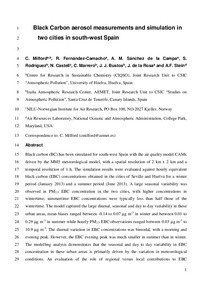Por favor, use este identificador para citar o enlazar este ítem:
http://hdl.handle.net/20.500.11765/13806
Black carbon aerosol measurements and simulation in two cities in south-west Spain
| Título : | Black carbon aerosol measurements and simulation in two cities in south-west Spain |
| Autor : | Milford, Celia
 ; Fernández Camacho, Rocío; Sánchez de la Campa, Ana María; Rodríguez González, Sergio
; Fernández Camacho, Rocío; Sánchez de la Campa, Ana María; Rodríguez González, Sergio


|
| Palabras clave : | Black carbon; Air quality; CAMx; Model evaluation |
| Fecha de publicación : | 2016 |
| Editor: | Elsevier |
| Citación : | Atmospheric Environment. 2016, 126, p. 55-65 |
| Versión del editor: | https://doi.org/10.1016/j.atmosenv.2015.11.026 |
| Resumen : | Black carbon (BC) has been simulated for south-west Spain with the air quality model CAMx driven by the MM5 meteorological model, with a spatial resolution of 2 km x 2 km and a temporal resolution of 1 h. The simulation results were evaluated against hourly equivalent black carbon (EBC) concentrations obtained in the cities of Seville and Huelva for a winter period (January 2013) and a summer period (June 2013). A large seasonal variability was observed in PM2.5 EBC concentration in the two cities, with higher concentrations in wintertime; summertime EBC concentrations were typically less than half those of the wintertime. The model captured the large diurnal, seasonal and day to day variability in these urban areas, mean biases ranged between -0.14 and 0.07 mu g m(-3) in winter and between 0.01 and 0.29 mu g m(-3) in summer while hourly PM2.5 EBC observations ranged between 0.03 mu g m(-3) to 10.9 mu g m(-3). The diurnal variation in EBC concentrations was bimodal, with a morning and evening peak. However, the EBC evening peak was much smaller in summer than in winter. The modelling analysis demonstrates that the seasonal and day to day variability in EBC concentration in these urban areas is primarily driven by the variation in meteorological conditions. An evaluation of the role of regional versus local contributions to EBC concentrations indicates that in the medium size city of Seville, local on-road sources are dominant, whereas in the small size city of Huelva, local as well as regional sources produce a similar contribution. Considering the large diesel share of the vehicle fleet in Spain (currently similar to 56%), we conclude that continued reduction of BC from diesel on-road sources in these urban areas is indeed a priority, and we suggest that targeted mitigation strategies, for example reducing the heaviest emitters in wintertime, would yield the greatest benefits. |
| Patrocinador: | The authors gratefully acknowledge funding from the Department of Innovation, Science and Enterprise of the Government of Andalusia through the research projects SIMAND (P07-RNM-02729) and (2011RNM-7800) and from the Department of Environment, Andalusian Regional Government (project: 199/2011/C/00). In addition, we thank the Spanish Ministry of Economy and Competitiveness for funding through the project POLLINDUST (CGL2011-26259). |
| URI : | http://hdl.handle.net/20.500.11765/13806 |
| ISSN : | 1352-2310 |
| Colecciones: | Artículos científicos 2015-2018 |
Ficheros en este ítem:
| Fichero | Descripción | Tamaño | Formato | ||
|---|---|---|---|---|---|
| AE_2016_Milford.pdf | 1,33 MB | Adobe PDF |  Visualizar/Abrir |
Los ítems de Arcimis están protegidos por una Licencia Creative Commons, salvo que se indique lo contrario.





